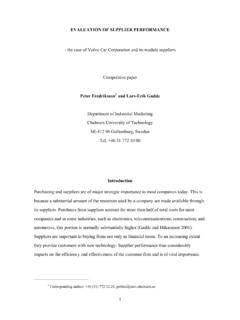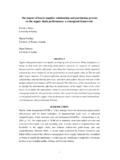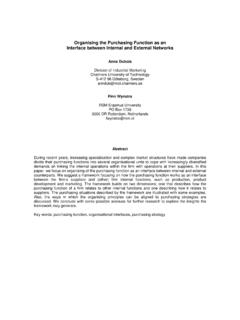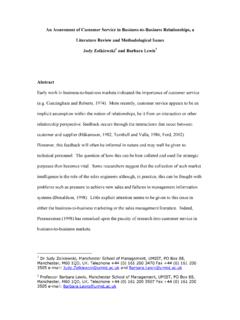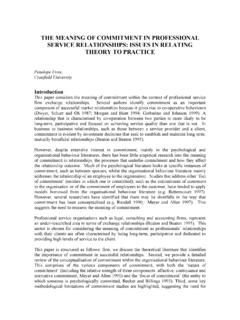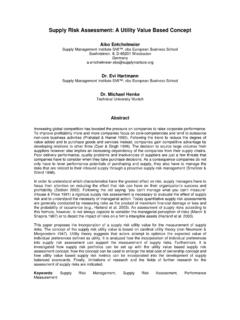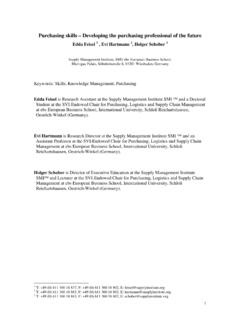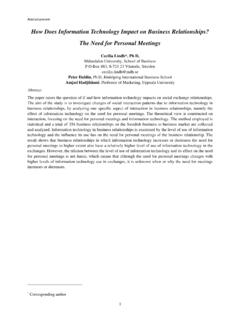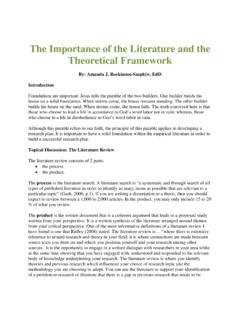Transcription of Managing Supplier Integration into Product …
1 - 1 - Managing Supplier Integration into Product development : a literature review and Conceptual ModelFinn Wynstra and Ferrie van EchteltEindhoven Centre for Innovation Studies/Institute for Purchasing & Supply development ,Eindhoven University of Technology, PO Box 513 - 5600 MB Eindhoven, NetherlandsTel. +31 40 2473841, Fax +31 40 2465949, paper presents a critical literature review concerning the effects of involving suppliersin Product development , the critical processes underlying the management of thisinvolvement and the potential driving and enabling factors for Managing supplierinvolvement in Product development . Together they constitute the building blocks for a input-throughput-output model that helps in understanding the crucial elements of howto manage Supplier involvement in Product development . This model draws on our previouswork in this area, but focuses more clearly on the inputs and outputs of managingsupplier to Managing Supplier Integration in Product developmentLiterature on Product innovation has been pervasively trying to distil the key ingredients forcompany success.
2 Many of the internal and external actors that are involved in productdevelopment - and the interfaces between them - have been subjects of research. Especiallythe interface between R&D on the one side and marketing and customers on the other side hasbeen investigated (Souder and Chakrabarti 1978; Souder 1988; Griffin and Hauser 1996;Sherman et al. 2000). Compared to this body of literature , the role of suppliers in contributingto company success via Product development has been addressed only in a limited way. Alsothe specific management role of the purchasing function regarding Supplier involvement fromthe customer side has attracted relatively little attention. The attention for this topic, however,has been on the suppliers in Product development has namely been argued to contribute to reduceddevelopment time, reduced development and Product costs and improved Product , the results of Supplier involvement seem to be mixed (Birou 1994; Hartley et ).
3 For example, involving suppliers early does not always lead to acceleration ofproject cycle time (Eisenhardt and Tabrizi 1995). Some authors conclude that, apparently, theway Supplier involvement is managed in the Product development process is important inexplaining the success of this Supplier involvement (Ragatz et al. 1997; Wynstra 1998).Both in Product innovation and in Supplier involvement literature , increasingly thoughts areadopted from contingency theory to address the topic ( Souder et al. 1998). Contingencytheory tries to understand and explain phenomena and organisational issues from a situationalpoint of view. The theory argues that companies face different environments and haveorganisational characteristics with a unique history that require differentiated managementapproaches and organisational structures.
4 Although many alternative views exist, the basicassertion of this research strand is that there is no one organisation or management approachthat leads to success. Companies need to adapt themselves to the most relevant aspects of theenvironments they are operating in. Applied to Supplier Integration in Product development ,this implies that the way that suppliers should be involved in Product development requires ananalysis of the situational factors and the critical processes to be managed. It is thiscontingency approach that could be valuable for understanding that there is no one way tolook at Product development and collaboration 2 -ObjectiveObjective of this paper is to develop a contingency-based model for designing and managingprocesses related to purchasing and Supplier involvement in Product development .
5 For thismodel we need to gain insight into :(1) the effects of involving suppliers in Product development and their measurement(2) the relevant Product development and sourcing processes,(3) the relevant factors that drive the need for a particular form of Supplier involvementand(4) the relevant factors affecting the ability of an organisation's purchasing function toorchestrate or carry out a particular role in these input for this analysis is a literature review1. The output will be a synthesis of relevantprocesses for Managing Supplier involvement in Product development , combined with a set ofsituational and enabling factors for successful Supplier involvement. We will refer to thissynthesis as the framework for integrated Product development and sourcing .We argue that in order to be successful, the involvement of suppliers needs to be embedded inthe wider context of bringing a purchasing perspective to the development process.
6 Such aperspective looks at the availability and suitability of external resources ( the knowledgeand skills of suppliers) for Integration in the development process under conditions of timelyavailability, and appropriate or optimal costs and quality of the input items (parts, materialsetc.) embodying those resources. This Integration of purchasing and Product developmentprocesses and considerations is what we mean by Integrated Product development andSourcing (IPDS) (Wynstra et al. 2001).An Input-Throughput-Output model for Integrated Product development and SourcingBased on various literature contributions and original research, our previous work has foundthat Managing Supplier involvement in Product development has both long and short termeffects (Wynstra 1998). Hence, Managing Supplier involvement encompasses a broader scopeof activities, independent of a specific project, which are carried out at different organisationallevels in the organisation.
7 Our model should therefore delineate the critical processes requiredto manage Supplier involvement at the strategic and at the project , as stated earlier, this model should provide insight in the factors that drive theneed for a specific form of individual or sets of activities. Finally, it is assumed that the abilityof a company to carry out activities in the framework is dependent on a number of model will be structured according to an input-throughput-output logic. The factorsaffecting the need for and ability of an organisation to perform Integrated ProductDevelopment and Sourcing processes will be seen as inputs, and the processes themselves asthroughput. The (desired) effects of these processes will be treated as the remainder of this paper consists of four sections. This includes the main body of thepaper, consisting of three parts, respectively dealing with the throughput, output and inputvariables of our model.
8 The last section of the paper is devoted to discussion and : the processes of integrated Product development and sourcingAs a starting point for our discussion of the basic processes involved in Managing supplierinvolvement, we use the model developed by Wynstra et al. (1999, 2000, 2001). 1 Where we refer to our own previous research, this consisted of 21 case studies in two European countries (theNetherlands and Sweden) and across a number of different industries, including the telecommunicationequipment sector, truck manufacturing, medical equipment sector, food packaging, plastic componentsproduction and power plant construction- 3 -This model distinguishes four management areas for Managing the processes directly andindirectly related to Supplier involvement in Product development .
9 Each management areaconsists of a specific set of activities: development Management: establishing the general policies and guidelines for supplierinvolvement in Product development , and the technological areas in which to collaborate; Supplier Interface Management: building an infrastructure or network of suppliers that cancontribute to Product development processes;Project Management: Managing the involvement of suppliers in specific developmentprojects; Management: helping to define actual Product specifications within a specificdevelopment each management area the following activities are proposed (see Table 1).Table 1 Integrated framework for purchasing involvement in Product development (Wynstra et al. 1999)AreasActivityDevelopment ManagementDetermining which technologies to keep/develop in houseFormulating policies for the involvement of suppliersFormulating policies for purchasing related activities for internal departmentsCommunicating policies and procedures internally and externallySupplier Interface ManagementMonitoring Supplier markets for technological developmentsPre-selecting suppliers for Product development collaborationMotivating suppliers to build up/maintain specific knowledge or developproductsExploiting technological capabilities of suppliersEvaluating suppliers development performanceProject ManagementPlanning.
10 Determining specific development -or-buy solutionsSelecting suppliers for involvement in the development projectDetermining the extent of Supplier involvementDetermining the moment of Supplier involvementExecution:Co-ordinating development activities between suppliers and buyerCo-ordinating development activities between different first tier suppliersCo-ordinating development activities between first and second tier suppliersOrdering and chasing prototypesProduct ManagementExtending activities:Providing information on new products and technologies developed or inmarketSuggesting alternative suppliers, products and technologies resulting in higherqualityRestrictive activities:Evaluating Product designs in terms of parts logistics, quality and costsPromoting standardisation and simplification of designs and partsAn important observation is that these management areas differ in time horizon and in thelevel of the organisation they are carried out.
